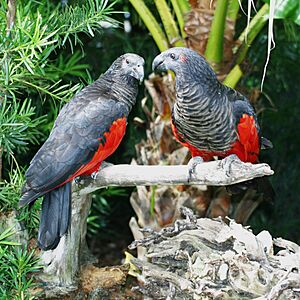Pesquet's parrot facts for kids
Quick facts for kids Pesquet's parrot |
|
|---|---|
 |
|
| At Miami MetroZoo, USA | |
| Conservation status | |
| Scientific classification | |
| Genus: |
Psittrichas
|
| Species: |
fulgidus
|
The Pesquet's parrot (scientific name: Psittrichas fulgidus) is a very special bird. It's also known by cool names like the Dracula parrot or the vulturine parrot. This unique parrot is the only one of its kind in the Psittrichas group. You can only find it living in the hilly and mountainous rainforests of New Guinea.
Contents
What Does the Pesquet's Parrot Look Like?
The Pesquet's parrot is a large bird. It can grow to be about 46 centimeters (18 inches) long. It usually weighs between 680 and 800 grams (about 1.5 to 1.75 pounds).
Its feathers are mostly black. It has greyish scales on its chest. But the most striking parts are its bright red belly, the feathers under its tail, and parts of its wings. If you see an adult male, you might notice a red spot behind its eye. Females do not have this red spot.
This parrot looks a bit different from other parrots. Its head seems unusually small. This is partly because it has bare black skin on its face. It also has a long, hooked beak. This special beak helps it eat its favorite foods. Its face looks a bit like a vulture, which is why some people call it the "vulturine parrot."
What Does the Pesquet's Parrot Eat and Do?
The Pesquet's parrot is a very picky eater! It mostly eats just a few types of figs. Sometimes, it might also eat flowers and nectar. In some areas, these parrots move around during different seasons. They follow where the best fruits are available. The bare skin on their face is thought to be a special feature. It helps keep their feathers from getting sticky when they eat juicy fruits.
Reproduction and Life Cycle
Scientists don't know much about how these parrots raise their young in the wild. They usually lay two eggs. They build their nests inside large, hollow trees.
These parrots are often seen in pairs. Sometimes, you might spot them in groups of up to 20 birds. When they fly, they flap their wings quickly, then glide for short distances.
Why is the Pesquet's Parrot in Danger?
Sadly, the Pesquet's parrot is a vulnerable species. This means it's at risk of disappearing. There are a few reasons why:
- Hunting: Its beautiful feathers are highly valued. This has led to too much hunting.
- Pet Trade: These parrots are also very expensive in the pet trade. This encourages people to catch them from the wild.
- Habitat Loss: The rainforests where they live are being cut down. This means they are losing their homes and food sources.
Because of these problems, the Pesquet's parrot is listed as "Vulnerable" on the IUCN Red List. This list helps track animals that need protection. It is also listed on Appendix II of CITES, which helps control the international trade of endangered animals.
Images for kids
-
Female at Cincinnati Zoo




